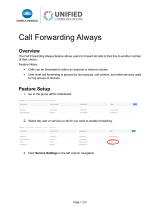
Call Park
........................................................................ 24
Paging (Intercom)
......................................................... 25
Redial
............................................................................ 25
Mute
.............................................................................. 26
4 Managing Incoming Calls ................................................... 27
Rejecting Calls
.............................................................. 27
Diverting Calls
............................................................... 27
5 Using Voicemail ................................................................. 28
Setting up the voicemail box for the first time
.............. 28
Retrieving messages from your Desk Phone
............... 28
Retrieving messages when you are away from the
office
............................................................................. 29
Returning a Call
............................................................ 29
Change your Voicemail PIN
.......................................... 29
Record a Personal Greeting via the Phone
................. 29
Forward Voicemail Messages via the Phone
............... 30
Logging into your Voicemail Box via the Web
.............. 30
Retrieving messages via the Web
................................ 30
Forward Voicemail Messages via the Web
.................. 31
Voicemail Notification via Email
.................................... 34
To Create a Voicemail Group
....................................... 35
Change the Number of Rings Before Voicemail Picks Up
....................................................................................... 36
6 Call Lists and Directories ................................................... 37
Managing Call Lists
...................................................... 37
Managing Contacts
....................................................... 38
Adding Contacts Manually
............................................ 38
Adding Contacts From Call Lists
.................................. 39
Editing Contacts
............................................................ 40
Deleting Contacts
.......................................................... 40
Placing Calls to Contacts
.............................................. 41
Searching for Contacts
................................................. 41
7 Customizing your Phone .................................................... 42
Configuring Basic Settings
........................................... 42
Changing the Appearance of Time and Date
............... 42
To configure the time and date formats:
...................... 43
Changing the Backlight Intensity
.................................. 43
To modify the backlight intensity:
................................. 44
Enabling the Headset Memory Mode
........................... 44
Selecting the Correct Headset for Electronic Hookswitch
....................................................................................... 45
To select a headset that supports electronic
hookswitch:
................................................................... 45
3






















